Luxury fibres like cashmere or vicuna can make lovely, indulgent cloths for sports jackets.
Having mostly stuck to linen, tweed or related mixes in recent years, I recently commissioned a jacket in 100% cashmere (from Eduardo de Simone) and it’s striking how soft and sumptuous it felt.
I had forgotten what the softness was like, and how nice a partner the short-haired texture can be for denim.
And yet it’s also great for formal jackets. That recent commission was in a mid-brown herringbone, but I also have old cashmere jackets in navy (from Solito) and a pale-oatmeal colour (from Caliendo – all pictured below).
The navy cashmere appears very smart when worn with grey trousers, a white open-necked shirt and dark-brown shoes – and yet doesn’t feel too formal or old-fashioned.
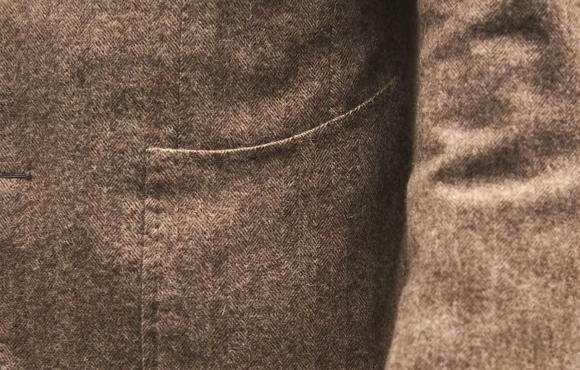
The problem with cashmere, vicuna and similar fibres is that they don’t wear well. Being soft, they’re more likely to wear down at the elbows, or the cuffs.
These jackets are a luxury in that sense as well, therefore: something to commission when you already have a range of harder wearing jackets in the wardrobe.
There are ways to mitigate the fragility of cashmere, however.
You basically want a cloth that has more body, the most important factor of which is the yarn (its thickness and how it is spun).

However, the yarn is not something you can easily find out, so the best thing is to look for proxies – like the weight – and consider the weave.
The best lasting will be a twill rather than a hopsack or plain weave, and a weight of 340g/11oz or above.
I made the mistake of getting a lightweight cashmere with my navy Solito, which was only 9oz and has had heavy wear, leading to it balding a little on the elbows.
Still, there are always nice suede elbow patches, right?
(By the way, the weave makes less of a difference with overcoats, where a greater variety of weaves and yarns are used to achieve different effects.)
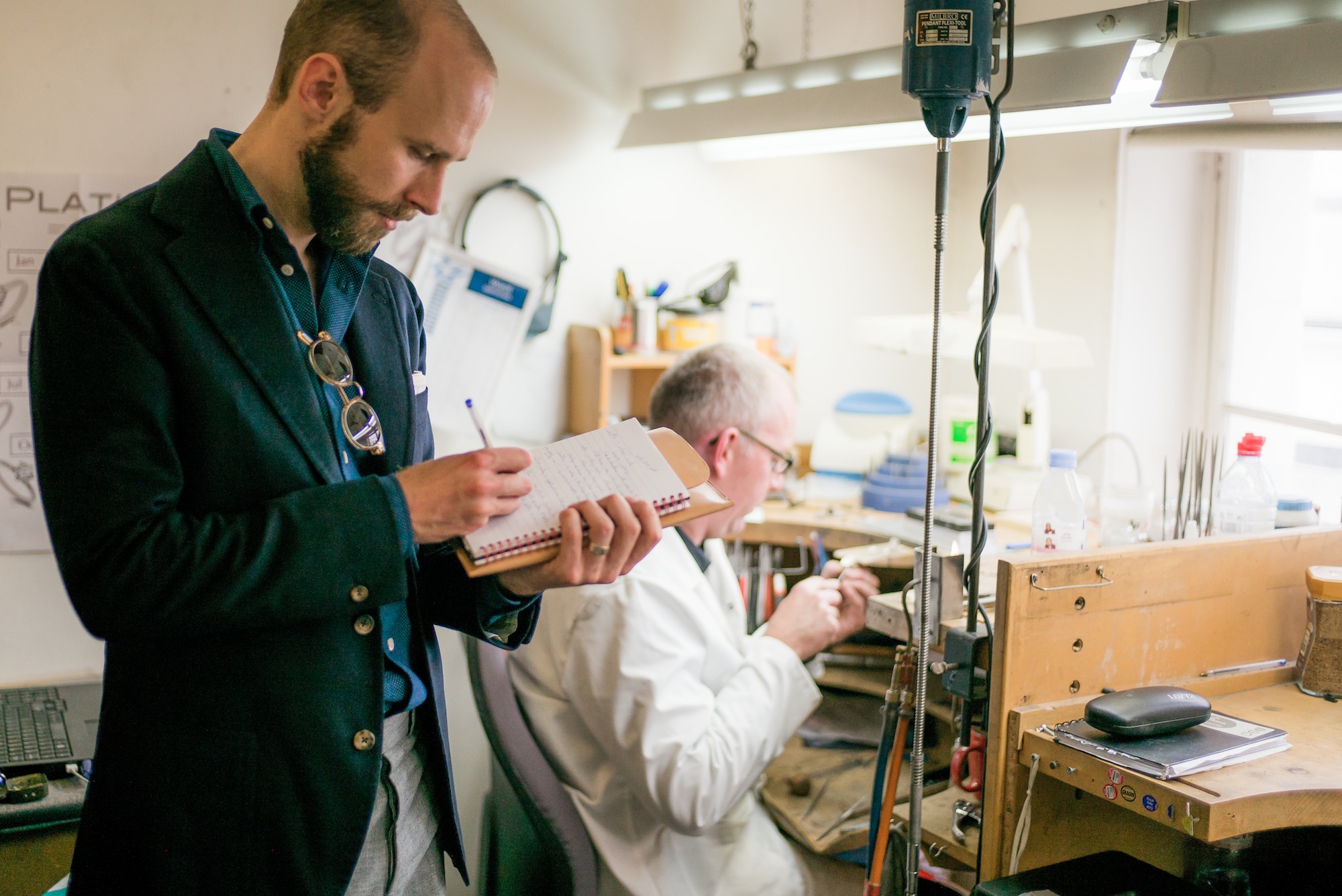
The softness of cashmere also makes it a poor choice for trousers, in general, and therefore for a suit.
Trousers in pure cashmere are likely to lose their crease, then their shape, and finally start bagging at the knees. Again, it’s a mistake I’ve made before: with a navy suit from Vergallo.
(If only this article existed six years ago!).
The only exception to this rule is worsted cashmere. Most cashmere cloths are woollens, because the fibres aren’t long enough to make into a worsted yarn. But by selecting only the longest fibres, it is possible to make one.
The problem is this makes the cloth more expensive, as it’s a further refinement of an already rare fibre. And a worsted cloth doesn’t necessarily have the softness you’d expect from a cashmere.
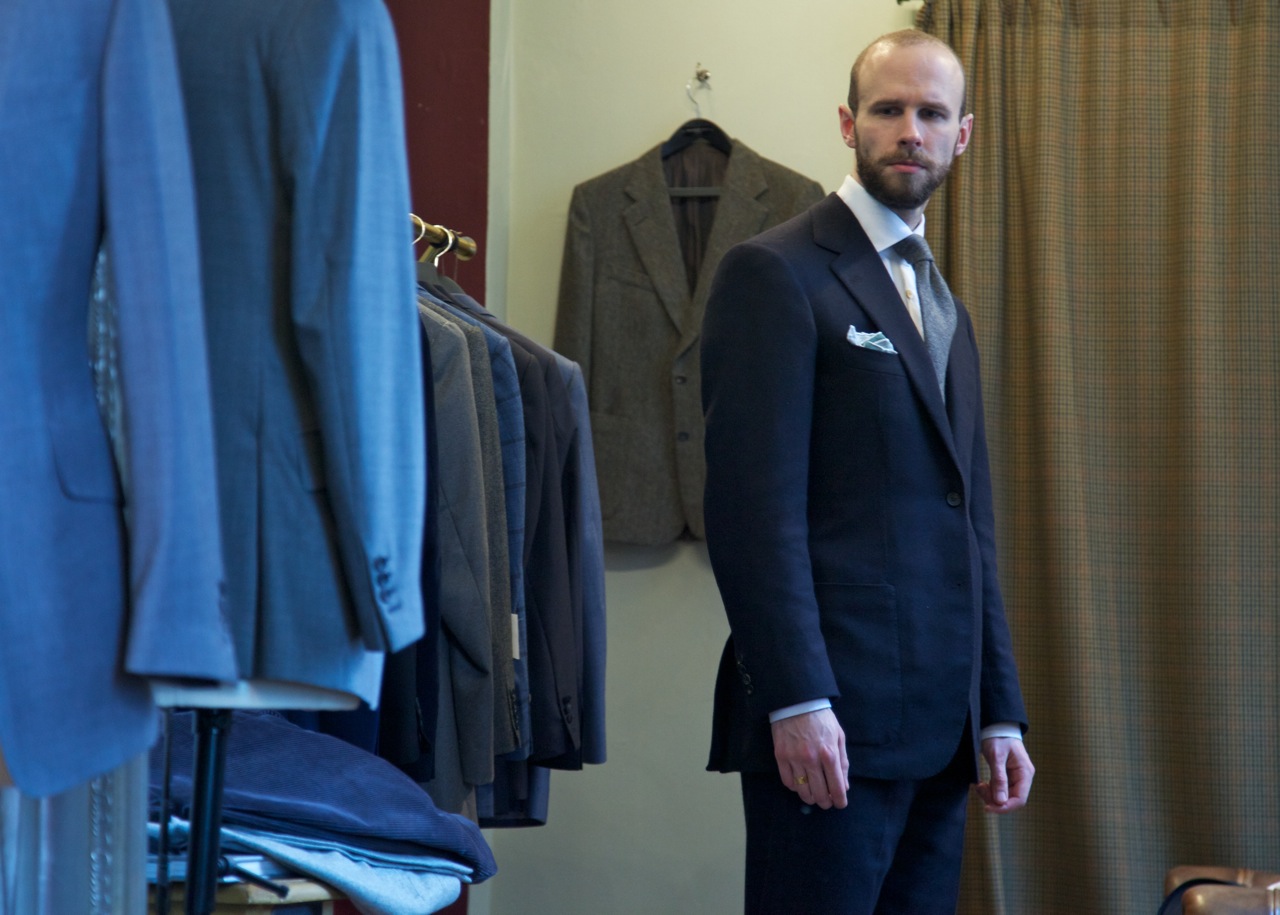
When it comes to qualities of cashmere, there is a big range, with the best coming from Mongolia and cheaper versions coming from the rest of China, Iran or Afghanistan.
But it’s very hard to tell them apart when selecting cloth, and in any case the ones used by the big mills don’t vary much. It’s just perhaps best to avoid precious fibres from unknown mills or merchants.
The biggest problem with cheap cashmere, by the way, is the mix of fibre lengths, which is what causes pilling. If you see a friend with a cashmere jacket that has pilled heavily, you know to avoid the cloth.
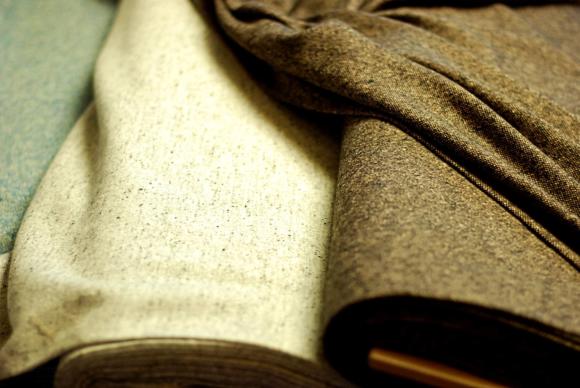
Other precious fibres like vicuna are so rare, and the supply so restricted, that there aren’t the same problems with quality.
The only slight variation in vicuna is colour. The majority is caramel brown, and can therefore only be dyed darker colours than that. Much rarer is white vicuna, which can be dyed lighter colours.
Other precious fibres include camelids like guanaco or alpaca. These are rarely used in menswear, and when they are it’s usually in a mix with merino.
The finer types of alpaca approach vicuna in softness, however, and share the same properties of tensile strength and thermodynamic performance (retaining warmth).
These include Sury (a rarer breed), Baby (an animal less than a year old, like baby cashmere) and Royal (the finest – baby alpaca with coarser hairs removed).
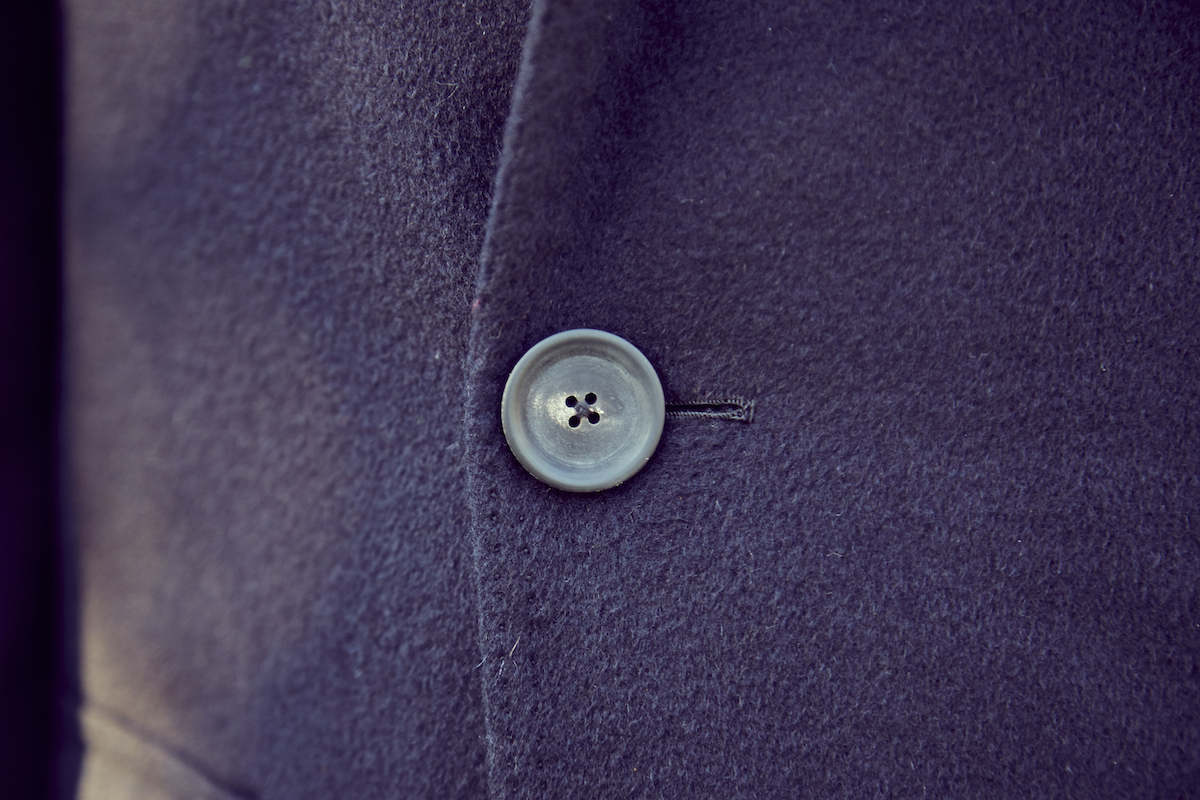
Cashmere jackets can be wonderful, but they do need looking after.
Brushing a cashmere jacket or overcoat is particularly useful, as it serves to separate those short, soft hairs. Worth doing regularly.
As to wool/cashmere mixes, the reason the cashmere is there is to make the cloth feel softer: some manufacturers will put a little cashmere in the mix to disguise fairly coarse wool elsewhere.
So my advice is to feel it and see if it’s actually softer than a nice 100% wool, rather than just assuming it is.
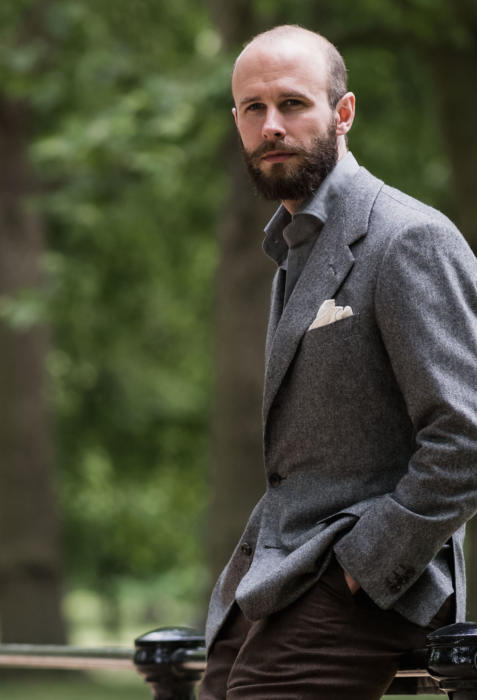


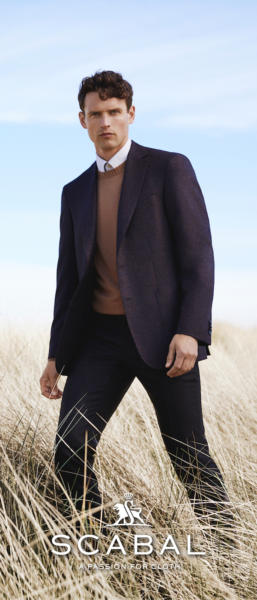
This is the most wonderful fabric knowledge site I have found in my search for knowledge and education on fabric! Thank you!
Hi Simon.
I am considering a bespoke grey Overcoat. It would be a formal piece, to be worn over a suit in a business environment.
My option was a mix of wool (85%) and cashmere (15%).
Would you go for a 100 wool option?
One more question, would you look for some pattern? Most of my trousers are grey, and maybe it would be a good way to make a difference.
Thanks
If it’s your one overcoat, which you will wear almost every day during the winter, then yes I would go for just wool. Otherwise, you can be more flexible.
And yes, some variation, mostly likely a herringbone, would be good to avoid clashing
Zegna produces a jacketing book – huayaca tweed that is about 50% alpaca, 45% wool and 5 % cashmere. They seem to be the only major producer that uses alpaca consistently. I’ll try to remember to wear one to the NY symposium later this month.
H&S does too
Sometimes, I bump into a wool fabric that is as soft as cashmere (without being a Super150+). I guess it is due to the finishing. Would you recommend those woodl as a proxy or do they not age well or wear harder than cashmere?
Donegal cashmere and to a certain extend alpaca are not offered in a wide variety, sadly.
Also, how about Escorial?
It’s hard to say, but chances are that a wool like that would have been heavily milled or otherwise finished to feel like that, and no probably wouldn’t last well.
Donegal cashmere is nice, yes, at least for the colour and texture variation.
Escorial is great, and does feel almost like cashmere. But it is very expensive too, and there the biggest advantage is its natural stretch. So pay that extra if it’s a priority
Not entirely relevant, but to be sure. Mongolia is an independent state, not part of China..
Sorry, thanks
At the risk of getting well of topic for PS Mongolia is an independent country, Inner Mongolia is an Chineese province.
Well, let’s not forget Inner Mongolia, which is in fact part of China, and also home to some of the better cashmere..
I’m sure this is unfair to the (I’m sure) hard working and dedicated herders of Inner Mongolia, but I don’t trust cashmere that comes from anywhere in China. Maybe it’s just an unconscious bias talking (my wife is Mongolian), but cashmere from Mongolia itself always seems to me to be of more consistently high quality than anything sourced from Inner Mongolia.
Well Keith I don’t think you have “unconscious bias”, you are biased because you are Sinophobic. Outtter Mongolia was also a part of China and gained its independance in the 20th century.
Not at all, Ziyou M. I’m very fond of China 🙂 My opinion is based on personal experience, which is the reason I’ve come back ten months later with what I hope may be a useful tip.
I’ve always found cashmere products of Chinese origin to be oddly poor wearing, pilling and bagging more quickly than anything I buy locally in Ulaanbaatar, and I’ve never understood why. I always assumed it was simply a matter of quality, but it came up in conversation last weekend while drinking with a friend of mine in the industry, and I learned that it’s about the relative strengths and weaknesses of the fabric between countries.
Mongolian cashmere is renowned for its long fibre lengths, which make it more stable and hard wearing, but my friend explained that the absolute best cashmere money can buy – in his opinion, at least, which comes with a couple of decades of experience – would be a blend of 70% Mongolian and 30% Chinese. The long Mongolian fibres give it the structure, but Chinese cashmere is softer and lends it texture.
I’d be tempted to suspect that he’d just swallowed a brochure and was promoting the blend his company uses, but as far as I know they only work with 100% Mongolian sourced fibres.
Lovely to meet you very briefly as you were leaving Stoffa on Friday + thanks very much for the sweatshirt recommendations, feeling slightly self-conscious that I wasn’t better dressed that day haha!
Just wondering, for a navy blazer that wears like your Solito but is slightly harder wearing – could you go for a wool instead, and if so which type?
Nice to meet you too!
I’d go for a wool, yes. I’d like a lightweight tweed version but a normal merino would be fine too
Thanks very much!
This is probably a slightly stupid question, but how does the merino you’d wear in a blazer differ to the worsted you’d have a suit made up out of? Are there any specific bunches you’d recommend for it?
Merino is the raw wool fibre, worsted is the way the yarn is made up (the opposite being woollen, which tweeds, flannels etc are)
No, I don’t have specific bunches off the top of my head.
So would a navy woollen flannel would work as a blazer? I’m still a little confused ha!
Most woollens, yes, but flannel generally no. Still more of a suiting
Don’t try to define it too closely, just look at bunches and think about whether it has enough texture
Would Harrison’s moonbeam work? I know online swatches are hard but was thinking a plain navy like this? Thanks so much!

Yes – see above
Hi Simon,
Great posts over the past weeks in addition to the coming excellent initiative about a very import issue!
As to this specific post, I just want to know whether adding suede elbow patches to your navy blazer , as you’ve suggested, wouldn’t affect its formality by making it a little bit more casual. I wouldn’t have asked this question, if its fabric were a tweed or anything else. For sure, there is no viable alternative.
John
Thanks John.
Yes, it would certainly make it less formal. A darker brown would help, and probably in suede, but the effect would be unavoidable really
Hey Simon, is there an equivalent in precious fibres for use in summer/tropical countries?
Good question. No, I don’t think so, unless you go into Super numbers – which are more precious types of sheep wool fibre
The supply of Vicuna is obviously artificially restricted and I wonder for how long.
Number of vicuna animals 1974: 6.000
Number of vicuna animals 2008: 350.000
The prices of the vicuna wool are as if the animal is still rare, which is simply not true anymore. Vicuna is neither rare nor endangered anymore and the absurd price is not justified. If the market was more liberal, the prices would have dropped drastically.
The high prices could last a long time. Gold remains expensive and yet it is mined by the ton. It has not been rare for a very long time.
And some brands (eg. Loro Piana) have made significant investments in marketing this above other yarns, that’s why it is not in their interest to reduce prices now.
Loro Piana was (or maybe still is) producing yarns out of much more rare and precious animals, but the quality increase is not really visible to humans, as production and finishing methods have significantly improved over the years.
It all boils down to marketing.
Lori Piana are the ones cheifly responsable for the saving of the vicuna animal and invested considerable amounts to their conservation, therefore I consider the increased price justified.
On the topic of caring for cashmere – I have a navy cashmere blazer, which I love the feel of, but has started to go a bit “hairy” (sorry, couldn’t think of a better way to describe it – some fibres being elongated, particularly on the edges and the front roll of the jacket. It is not pilling the way I understand it on a woolen jumper).
Is this normal or does it say something about the quality of the cashmere?
Will brushing the jacket help? Should I trim the extended fibres?
Thanks in advance for any help.
It’s hard to say remotely, but it might suggest the fibres have too much variation in length, yes. Brushing is a good idea; trimming onto as a last resort
I have nine cashmere jackets (is four in navy, in different weights, over the top? Yes.). They are all Loro Piana and I’ve worn them exclusively for seven years or more.
None show any signs of wear, even the summer cashmeres.
All I can suggest is get the best fabric. None of my jackets or suits has ever been dry cleaned BTW.
They are all MTM and that suits me perfectly.
Once you experience cashmere you may find it hard to turn back.
Vicuna…..Always makes me think of the scene from the film Sunset Boulevard, when Norma takes Joe shopping for some clothes.
A rather slick sales representative points out an overcoat and reveals it is made of vicuna.
When Joe says it sounds extravagant (and expensive), the Sales Rep it shouldn’t matter as “the lady is paying for it”……Joe gets the coat….
I was in high school at the time (the movie was on afternoon television decades after it was made – no, I didn’t see it when it first came out!) and I remember having to look up exactly what vicuna was.
Somehow, every-time I read something about vicuna now, I attribute its’ desirability being ever so slightly enhanced by Sunset Boulevard……
I’m looking into a commission for an overcoat, a bit of a tweak on a polo.
Any thoughts/recommendations on fabric choice? Ideally something that is regularly wearable through a London winter (so probably not a light tan camel!) with enough texture to be visually interesting.
Any recommendations or advice on where to look much appreciated.
If you want versatility then probably go for a navy or grey. If you want visual interest, that will be easier in grey, for example a herringbone. And go for 100% wools unless you already have some good overcoats and this one won’t get heavy wear.
Thanks Simon.
How about a casentino in 100% wool? I think they do sometimes come with a little bit of more exotic in the mix like cashmere or alpaca but these would be less durable (?).
Also any thoughts on where I might be able able to source casentino would be much appreciated.
Casentino would be nice, though of course it’s a very particular look.
Caccioppolli used to offer it in their overcoatings, but I don’t think they do anymore. I don’t know any others, sorry.
I do like the Rubinacci RTW ones the Rake sells
Simon,
One thing you didn’t mention – how exactly to pronounce the word “vicuna”
I tried to find a definitive answer, and there seems to be many variants
veh – coon – ya
vi- kuneh
etc..
Any thoughts, or preferences? Even some of the YouTube videos (ranging from the Loro Piana piece, through National Geographic) are undecided….
I’d go with the former, but I’d imagine one is the original Spanish word, the latter is the more Anglicised
For anyone interested in cashmere Derek Guy (Dieworkwear) has just published a great article on the subject. More focussed on kinitwear but enlightening nonetheless.
I’ve lived in Mongolia on and off for the last nine years, and as a result my wardrobe is full of cashmere items – mostly scarves because I’m a skinflint, and I prefer hard wearing fabrics for jackets and the like.
My absolute favourite cashmere item, though, is a sleeping mask from Gobi Cashmere. I stumbled on it a few years ago at their outlet store in Ulaanbaatar, and since it was reduced to about $30 I thought it was worth giving it a try. It’s bloody amazing. Never take a flight without it, and I’m out like a light by takeoff.
The guidance you give on how fragile cashmere is imediatley obvious on the blue jacket of the suit you model. Invariably tailors press the sleeve head last. Those on the blue jacket look crisp and ready for action.. the lower forepart by contrast is already looking tired. Of course you could argue that this is part of the charm of this cloth rather like a leather sofa that has had some .abuse
Hi Simon
I’ve found a plain brown Loro piana cashmere (300g) that I really love (I think it might be from the same bunch as your oatmeal cashmere because it has the same twill texture) but it doesn’t have any real pattern or surface interest. Would this be too smooth for dark jeans or cotton trousers? I would’ve thought it would quite versatile with different colour trousers in any case?
That sounds nice Mac – I’d perhaps just try to wear it with some pattern elsewhere, eg in the shirt? And my only concern with the cashmere is it might be too smooth and luxe for jeans. Great with flannels etc though
Hi Simon, Thanks for this article – really extremely useful! Two questions – where would you start looking for a Donegal-style Cashmere cloth for a very softly tailored sports coat to go with informal trousers? I am also thinking about commissioning a navy overcoat in cashmere, around 18oz in weight. I´ve always thought of Loro Piana as the non-plus-ultra of cashmere cloth, but my tailor suggested Drapers (“not really worth the price difference”) – would you think there´s a difference in quality? I didn´t really feel any, but it might have been the small swatch. Thanks, as always, Jan
You’ll have to look through all the bunches Jan, it varies a.lot from season to season which Italian ones have any cashmere donegals. And no, there won’t be a big difference
Hi Simon
I’m have a favorite suit of mine made form a worsted wool/cashmere/silk cloth from H&S, its very light at only 240g/7oz and I try wear it infrequently.
Would any of your above care advice change for a cloth of this blend & weight?
Kind regards
Nick
Not a lot, but brushing will matter slightly less because there will be less of a nap (hairy texture) on it
Still trying to understand the durability of camel hair. Just purchased Ralph Lauren polo coat in camel hair but I’m concerned that it will wear quickly. I’ll wear it 3 or 4 times per month. How long before it shows wear at cuffs, collar?
With that kind of wear, you should be fine. Years I’d imagine.
Simon,
Is it possible you could specifically list one or two cashmere fabrics (whether it be Loro Piana, Draper or any other respected maker) that would be appropriate for a double-breasted Navy chesterfield style overcoat? I need to choose the cashmere swatch somewhat soon and I’d be very grateful if you narrowed the choices.
I have multiple long coats and trench coats for various weather scenarios – so this cashmere will be for special winter occasions in Europe, Canada and northern US. Usually with a suit underneath. I’ll take good care of it, brush it, hang it carefully, etc. I want it to last 20+ years and age gracefully. I know the tailor will show me multiple books with cashmere choices but I’d like to go in to this process already knowing that I have a target fabric and weight in mind. I don’t want to rely on simple hand feeling the fabric and making a quick decision.
What exact cashmere (maker, weight, etc) would you choose for a traditional/formal DB overcoat given the lessons you learned? Also for a Chesterfield collar, what complimentary fabric would you choose? Black velvet or something else? Many thanks!!
Hi Robert,
I’d love to help, but I’m afraid I haven’t looked for something similar for myself recently, so this would involve going to a tailors and spending a good while looking through all the options…
Hopefully we will do a version of our Linen feature sometime soon which will review all the bunches available.
In the meantime, feel confident that you’re on safe ground given you already know what colour and fibre you want, and this piece gives good guidance on weight. You can’t go much wrong after that.
S
Simon,
Down to two choices for my 100% cashmere long overcoat: both are Loro Piana and selling at close-out price.
One choice is 23 ounce ‘double-facing’ (Navy blue) cashmere.
Other choice is 19 ounce ‘single’ dark grey cashmere.
Both are appropriate color choices and the tailor indicated he could work equally well with either material. The double facing is slightly more expensive.
Any thoughts on double-facing cashmere besides the interior lining issue?
Thanks, Robert
Have a great weekend!
Sounds like nice choices Robert. I would go for the navy just because it’s usually a more useful colour and the weight will be great…
Hi Simon,
Any thoughts on baby camel hair for sport coats?
Can be nice. Often cheaper and slightly harder wearing than cashmere. Looks a little less luxe as well
Hi Simon,
Thanks – I was considering it as a more durable alternative to cashmere so it may be a good option to consider.
I saw a beautiful escorial wool which is about 300g. Would it be too hot for summer? How does the quality compare to golden bale wool?
No that should be ok.
The quality is as high, but different – Escorial’s quality comes from its soft handle and natural crimp/stretch, rather from fineness
Hi Simon,
How much cashmere is actually acceptable in trousers without them loosing their crease or bagging at the knees?
Is it worth considering a suit with the following cashmere blend: 62% Cashmere 25% Wool 7% Vicuña 6% Silk?
I’d worry about anything more than 10% to be honest, and to be safe avoid it altogether.
But it does also depend on the yarn, weave, density and so on. In the end, if that cloth you describe is woven to be worn as a suit, it won’t be too bad. Because it will likely be worsted, densely woven etc, to make up for the softness of the fibres
Simon, what would you say about a cashmere/silk blend? I’ve just thrifted a half lined gray herringbone jacket made with this odd material. Even more unusual is the fact that it’s 50/50. The fabric is lovely and it cost almost nothing (10$? Seriously?), but I wonder how will this work. Will the added silk turn it more into spring/fall jacket? It’s rather lightweight. Or 50% cashmere is enough to make it unwearable above 20 C?
I think it will be more Spring and Autumn, though depends on the weight as well as the fibre mix.
The fabric seems to be a bit over 300g, but that’s a very rough estimation. It’s the herringbone that got me thinking…. It’s basically a twill, and twills are fairly tight, correct? But then lightweight chinos are also twills and they work in 30+ degrees
Yes twills are generally tighter, but that’s only one factor in the cloth. You can still have a lightweight twill (or herringbone)
is 400g heavy enough for a cashmere sportscoat?
Yes, that’s pretty heavy by most you see RTW today. It would be a good weight
Simon. I understood Vicuña was sensitive to chemical treatments, but your article suggests it’s because the majority is very dark in its natural state. Does this mean both are true, in that the fibre would require (destructive) bleaching before dying for most colours? Just saw a very nice Vicuña body coat on Michael Browne feed. How much would that typically add to the overall cost for the same coat between wool blend, cashmere and Vicuña respectively. Let’s say the wool version was £7000.
Would you happen to have any thoughts about a very fine cashmere vs. cashmere vicuna blend? I have been considering saving up for a dramatic black or midnight blue double breasted jacket in such a fabric, usually the colour being somewhat uninteresting for my tastes.
Found a few interesting ones, but on seeing the fabric swatches it got more confusing as the vicuna blend (nearly 50%) seemed ever so slightly coarser. And the finest cashmere ones had a gentle ripple effect which is different from the vicuna texture.
It’s rather intimidating to make a call based on such a small piece of fabric so thought to ask your opinion as I’m sure you have seen more than anyone I could think of. Thank you in advance!
Hi Ram,
That ripple effect is often used on cashmere, though I don’t know why it wouldn’t be on vicuna. It does make the cashmere look very luxurious, if that’s the look you want.
To be honest, if you don’t immediately like the feel of the vicuna, I wouldn’t go for it. It will be rather more expensive, and the only reason would be if it had a real ‘wow’ factor when you touched it.
Hi Simon,
That’s a very good observation. As this is a blend without that natural golden colour of vicuna and the touch hasn’t been sensational (unlike the 100% vicuna scarves) it’s just a matter of collector’s curiosity rather than any clear preference unlike the cashmere vs wool.
I’ll just a keep en eye out for a short while for any vicuna blends that might have that ripple texturebut very much leaning towards your advice otherwise.
Thank you as ever for maintaining such a informative posts. Perhaps someday you might also add qiviut and yak down to the list of fabrics? Though I have never seen any suiting fabrics for either. Cervelt is perhaps too rare to be interesting.
Enjoy your weekend!
Cheers Ram.
I did use yak here by the way.
Cheers Simon, and indeed you have covered yak very well. My bad for assuming it was all here.
No worries. That is of course only one type and fineness of yak too. I haven’t gone into it in any detail
Hi Simon,
I’m interested in a particular jacket cloth from H&S, link below. A wool / cashmere mixture, 9oz. A swatch feels very soft; it has fine nap. But holding it in hand, your recommendation “no flannel for a sport jacket” crossed my mind, because it reminds me of that favourite material of mine. Yes, I would say it certainly has more texture, but still I’m not sure, if the material is suitable to be a separate (despite being marketed as such). That said, I’m a novice in the world of separates. The H&S website picture gives a good idea about the actual texture (nap and weave under it).
And 9oz weight. Given the high percentage of wool, wearing down at stress points should not be a serious concern, I guess, or does even the low percentage of cashmere means problems here? Never have worn cashmere yet.
https://apparel.hollandandsherry.com/en/fabric/use/jackets/9019601-sherrykash-charcoal-solid
Thanks a lot!
J.
Hi John,
If it’s made for a jacketing, it should be OK. I wouldn’t worry there as far as the weave and material is concerned.
And yes, it will be a little less robust and perhaps wear down, but that will be the case with any summer jacketing weight like this – that little bit of cashmere won’t make much difference there.
My minor concern would be the colour and lack of texture. Charcoal is OK, but you might find it’s not that versatile without any pattern to it. A herringbone might make things easier (eg, if you wear it with a plain shirt and no tie, there will be little of interest going on in the whole outfit)
Hi Simon,
a good point about the colour and texture.
My use of this colour would be for a double-breasted jacket, always worn with a tie. Given my strong predilection for light blue stripes on shirts, charcoal ought to bring some seriousness to such an outfit.
My only doubt is quite contrary to yours: I picture it with pale beige trousers. What do you think, would such a strong contrast be beneficial to the whole (this charcoal seems to me of even darker shade than e. g. your Vestrucci flannel suit)? Comparing the swatch side by side with pale tan calvary twill, I certainly wouldn’t call it a garish combination, but, well, that could be a beginner’s fallacy! On the other hand, a dark charcoal jacket with light grey trousers seems to me a rather boring combination.
Thanks!
J.
Hi John,
Oh good, that makes sense then.
I do think it could work nicely with beige trousers, yes. It depends on the precise tone, obviously, but I think that would be good, as well as pale grey, cream, maybe mid-green and mid-brown too
S
Hi Simon
Great read as usual, I’m looking to commission a cashmere jacket from a loro piana “Cashmere Cloud” cloth N694035 but notice that it’s very lightweight at 220 grams (93% cashmere 7% silk).
The tailor has suggested that the weave is very tight and that will help with durability, understand that it’s hard without seeing the cloth but would you avoid this from just seeing the weight?
Also not sure if you are familiar with LP’s regular 100% cashmere range, there are 300grams options (ps. I live in a warmer climate)
Thank you
That is very light, yes. If you don’t already have a few summer jackets in the wardrobe, I would worry about the longevity
Hi Simon,
I’m living in the tropics and considering ordering a sports coat in a lora piana 100% cashmere fabric 310 grams. I would order unlined to minimise heat retention. I’m trying to get a sense of how warm it would wear. I find there can be a huge variation in heat retention at 300g depending on cloth weave.
I know it won’t be wearable outside aircon (almost no jacket is). Would you wear a jacket like this in UK summer?
I wouldn’t wear it in the summer myself, no. Cashmere is so much warmer for the weight, that I would go for a lightweight wool at the most, but more likely a wool mixed with linen or linen and silk
There is another rare fibre-lotus silk. Love to know more about it.
I’ve also been reading up on Loro Piana and the brilliant article on their cashmere, black merino…it has another name..can’t remember, also baby cashmere and vicuña on their website. Also their interesting “green policy”. There are surely other rare natural fibres out there which in themselves are fascinating to learn about.
The point I’m trying to emphasise here is:-
Who are the honest, ethical and reliable vendors of these rare fabrics.
Where can we go and buy them? Where do you buy clothing items in cervelt tfor instance?
Ok, you’ve Loro Piana and probably Zegna for cashmere,vicuña, black merino.
There are others, including the various tailors etc. It’s knowing where to find them!!
Would make a fascinating article in itself
Thanks Lindsay. I guess two different questions there – one about where to get different rare fibres, the other generally on ethical suppliers of them. That’s not something I’ve ever looked into in a comprehensive way
Disregarding the price, does vicuna make sense to be used for trousers?
No, not really. It will mean the trousers lose their shape unless it’s only in small quantities – and if it is, then what’s the point?
I have a question, please. I’m looking into a local mill that is going to send me some swatches of a flannel wool and alpaca mix from domestic farms. Not sure the proportions or the cost, but looking at a 400 g weight.
Taking your recommendation, Simon, I’m looking to make a pair of bespoke grey flannel trousers.
My question is, what should I look out for? I wouldn’t want it to be a bust, and I can always look at a 100 percent wool flannel, instead.
I guess if it’s for trousers, Simon, make sure the material feels as dense as a normal flannel, so it will hold a sharp crease
Hi Simon, if you had a choice for vicuña overcoat which colour would you go? Caramel brown, dark navy, dark brown or? Thx Henry
Entirely depends what other coats I had, Henry. If I effectively had none, then certainly navy
Hi Simon, thank you. If I had already navy (not in vicuña) in my wardrobe what would be your second choice? Thx a lot
Then I would say probably dark brown or a grey, perhaps a mid-grey with some kind of texture like a visible herringbone. Though these are relatively formal, so it does depend obviously on your lifestyle as well
Hi Simon.
I hope you pick up this on such an old nevertheless brilliant article.
I wanted to ask do you have any recommendation of any English mill for 80/90 percent wool with 10/20 percent cashmere around 400 gms for a jacket / blazer.
Keep up the good work.
With my best
AKG
Hi AKG,
Absolutely, I always answer on any post, no matter how old. It’s just one stream of comments in the admin site for me.
I don’t have a specific recommendation in mind, as I haven’t looked for that for a while. I’d look at the likes of Fox and W Bill, and I’d look in the coatings bunches of the Italians, who sometimes go down surprisingly light.
Simon re suede elbow patches in general what are your thoughts – do they visually enhance any jacket? Apart from adding when elbows are obviously wearing through would you ever commission a new tweed sports coat, tweed suit or indeed any other type of coat with them? Do you think they look elegant ? What about on cardigans? Thank you.
I wouldn’t ever, no. The style can be nice, but it’s not one I personally like that much. It can easily look a little showy or a little old-fashioned – there’s not a lot of space in the middle. When it is done well though, it’s in Loro P/Cucinelli colours, like brown suede or grey or natural.
Hi Simon,
Any specific bunches you like for cashmere jacketing? I know piacenza, cacciopoli, johnston of elgin but how do they compare to loro piana?
Johnstons, Harrisons and the other English mills tend to be denser, which I like, but the quality otherwise is similar. Loro Piana stands out most for its designs and colours